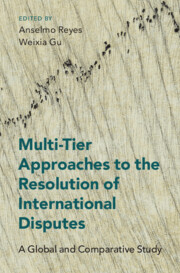Book contents
- Multi-tier Approaches to the Resolution of International Disputes
- Multi-tier Approaches to the Resolution of International Disputes
- Copyright page
- Contents
- Figures
- Tables
- Contributors
- Acknowledgements
- Table of Cases
- Table of STATUTES AND INSTRUMENTS
- Table of Rules, Codes and Guidelines
- Abbreviations
- Part I A Global Overview of Multi-tier Dispute Resolution: Main Themes
- Part II Multi-tier Dispute Resolution in Asia
- A General Trends
- 3 Combinations of Mediation and Arbitration
- 4 The Resolution of International Commercial and Financial Disputes
- 5 Multi-tier Dispute Resolution
- 6 Perspectives and Challenges of Multi-tier Dispute Resolution in Japan
- 7 Might There Be a Future for Multi-tiered Dispute Resolution in Korea?
- 8 Combinations of Mediation and Arbitration
- B Specific Cases
- Part III Multi-tier Dispute Resolution in the Wider World
- Part IV Conclusion
- Bibliography
- Index
5 - Multi-tier Dispute Resolution
Present Situation and Future Developments in Taiwan
from A - General Trends
Published online by Cambridge University Press: 09 December 2021
- Multi-tier Approaches to the Resolution of International Disputes
- Multi-tier Approaches to the Resolution of International Disputes
- Copyright page
- Contents
- Figures
- Tables
- Contributors
- Acknowledgements
- Table of Cases
- Table of STATUTES AND INSTRUMENTS
- Table of Rules, Codes and Guidelines
- Abbreviations
- Part I A Global Overview of Multi-tier Dispute Resolution: Main Themes
- Part II Multi-tier Dispute Resolution in Asia
- A General Trends
- 3 Combinations of Mediation and Arbitration
- 4 The Resolution of International Commercial and Financial Disputes
- 5 Multi-tier Dispute Resolution
- 6 Perspectives and Challenges of Multi-tier Dispute Resolution in Japan
- 7 Might There Be a Future for Multi-tiered Dispute Resolution in Korea?
- 8 Combinations of Mediation and Arbitration
- B Specific Cases
- Part III Multi-tier Dispute Resolution in the Wider World
- Part IV Conclusion
- Bibliography
- Index
Summary
Taiwan has had many legal provisions for multi-tier dispute resolution, including court-annexed mediation for civil disputes, family disputes and labour disputes. Based on the parties’ autonomy, the parties are free to choose their way of dispute resolution. If the parties explicitly agree in a contract to ‘first mediate, and then arbitrate’ or to arrange other multi-tier dispute resolution procedures, those clauses should be legally binding and enforceable. The multi-tier dispute resolution clauses could lead to a litigation or an arbitral proceeding as inadmissible. However, the effect of those clauses is not observed ex officio; a party has to raise the objection of non-compliance with the procedure. Since the performance of multi-tier procedural clauses does not affect the arbitral agreement and the jurisdiction of the tribunal, non-compliance with those clauses should not be a ground for setting aside the arbitral award.
Keywords
- Type
- Chapter
- Information
- Multi-Tier Approaches to the Resolution of International DisputesA Global and Comparative Study, pp. 110 - 141Publisher: Cambridge University PressPrint publication year: 2021
- 1
- Cited by

